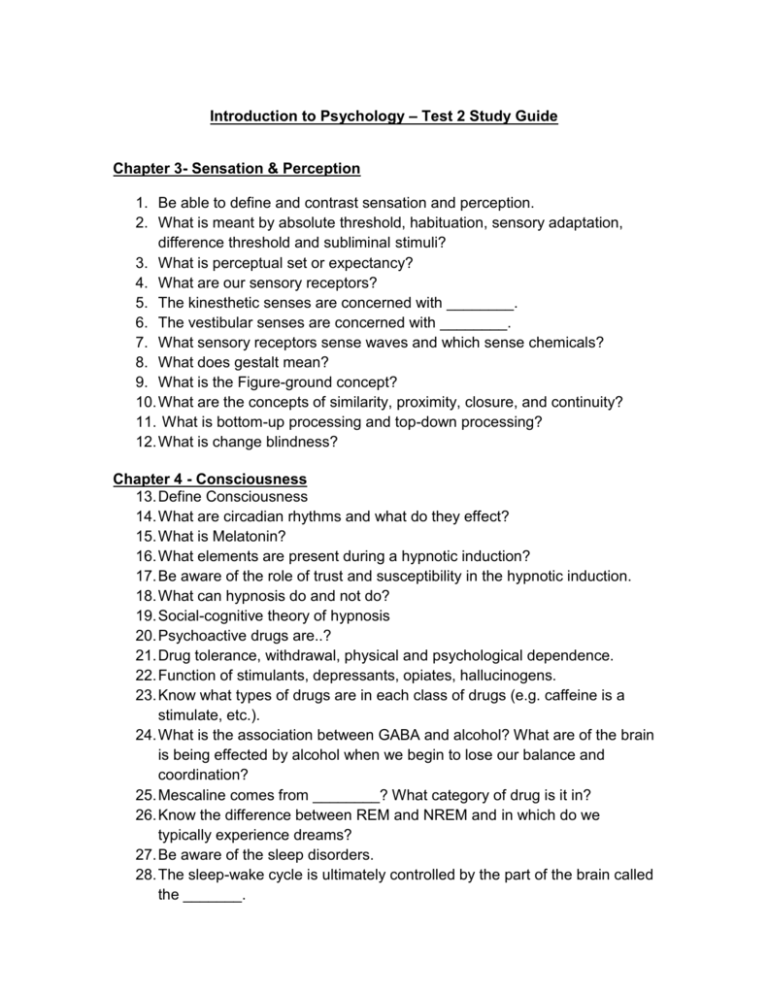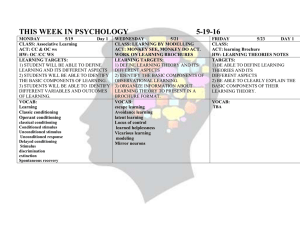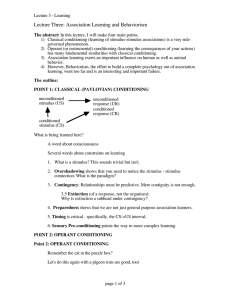Psychology Test 2 Study Guide: Sensation, Consciousness, Learning
advertisement

Introduction to Psychology – Test 2 Study Guide Chapter 3- Sensation & Perception 1. Be able to define and contrast sensation and perception. 2. What is meant by absolute threshold, habituation, sensory adaptation, difference threshold and subliminal stimuli? 3. What is perceptual set or expectancy? 4. What are our sensory receptors? 5. The kinesthetic senses are concerned with ________. 6. The vestibular senses are concerned with ________. 7. What sensory receptors sense waves and which sense chemicals? 8. What does gestalt mean? 9. What is the Figure-ground concept? 10. What are the concepts of similarity, proximity, closure, and continuity? 11. What is bottom-up processing and top-down processing? 12. What is change blindness? Chapter 4 - Consciousness 13. Define Consciousness 14. What are circadian rhythms and what do they effect? 15. What is Melatonin? 16. What elements are present during a hypnotic induction? 17. Be aware of the role of trust and susceptibility in the hypnotic induction. 18. What can hypnosis do and not do? 19. Social-cognitive theory of hypnosis 20. Psychoactive drugs are..? 21. Drug tolerance, withdrawal, physical and psychological dependence. 22. Function of stimulants, depressants, opiates, hallucinogens. 23. Know what types of drugs are in each class of drugs (e.g. caffeine is a stimulate, etc.). 24. What is the association between GABA and alcohol? What are of the brain is being effected by alcohol when we begin to lose our balance and coordination? 25. Mescaline comes from ________? What category of drug is it in? 26. Know the difference between REM and NREM and in which do we typically experience dreams? 27. Be aware of the sleep disorders. 28. The sleep-wake cycle is ultimately controlled by the part of the brain called the _______. 29. Why was Freud interested in dreams? 30. What is the difference between the latent and manifest content of the dream? 31. What are the symptoms of sleep deprivation? 32. What is REM deprivation? 33. What are three "helpful hints" to avoid insomnia? 34. Is too much sleep dangerous to our health? Chapter 5 – Learning 35. What is learning? 36. What is conditioning? 37. What is a stimulus? 38. What is a response? 39. What is motivation? 40. What is classical conditioning? 41. What is an unconditioned stimulus? 42. What is a conditioned stimulus? 43. What is an unconditioned response? 44. What is a conditioned response? 45. Be able to distinguish or list the UCS, UCR, CS, & CR from Pavlov’s experiment involving the meat and bell. 46. What is Stimulus Generalization? 47. What is Stimulus discrimination? 48. What is Extinction? 49. What is Spontaneous recovery? 50. Be able to distinguish or list the UCS, UCR, CS, & CR from Watson’s experiment with Little Albert involving the loud noise and the rat. 51. What is vicarious conditioning? 52. How does our biological preparedness protect us from danger? 53. What is a taste aversion? 54. What is operant conditioning? 55. What is a reinforcer? (What are primary and secondary reinforcers?) 56. What is shaping? 57. What is a positive reinforcement? 58. What is a negative reinforcement? Be able to identify negative reinforcement in a scenario. 59. What is punishment? Be able to identify punishment in a scenario. 60. What are some of the problems with punishment? 61. What is the difference between continuous and partial reinforcement scenarios? 62. What is observational learning? 63. What is modeling? 64. What is learned helplessness? 65. What is the difference between extinction in classical conditioning and extinction in operant conditioning? 66. What is the difference between schedules of reinforcement that are interval versus ratio?











